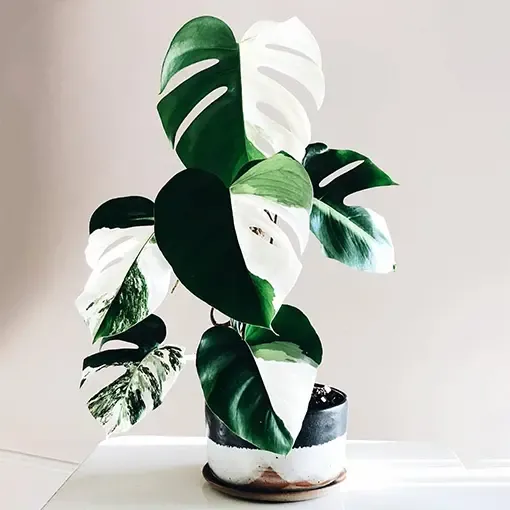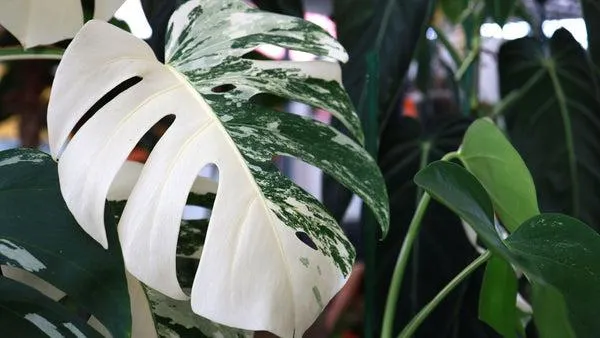Understanding white variegation in monstera deliciosa plants
The monstera deliciosa, also known as the Swiss cheese plant or window leaf plant, is one of the most popular houseplants around. Often grown for its unique perforated leaves and impressive tropical appearance, it has become a décor staple in many homes. However, some monstera plants develop leaves that are partially or fully white in color rather than the typical dark green – this is known as white variegation. In this article, I’ll explore what causes white variegation and address common questions people have about caring for monstera deliciosa plants with white leaves.
What causes white variegation?
White variegation occurs due to a genetic mutation in the plant’s chloroplasts, the structures that produce chlorophyll – the green pigment responsible for photosynthesis. When chloroplast development is disrupted, areas of the leaf don’t produce any chlorophyll and appear white, cream or yellow instead of green. This mutation is usually spontaneous and occurs at random, so variegated monstera plants are considered quite rare. From my experience propagating variegated plants, sometimes the trait carries over to new growth and other times it doesn’t.
The exact genetic and physiological mechanisms behind variegation aren’t fully understood. It’s kind of like how humans are born with traits we don’t always pass on to our kids. But in general, variegation makes areas of the plant less efficient at photosynthesis since they lack chlorophyll. That’s part of why variegated monsteras require some special care.
Caring for a monstera with white leaves
- Provide extra light. Since white sections can’t photosynthesize, variegated monsteras need significantly brighter conditions than their fully green counterparts. I keep mine in an east or west facing window.
- Be diligent with watering. Without chlorophyll, white parts are more vulnerable to drying out. Water when the top inch of soil is dry but don’t overwater, which can lead to root rot. Proper drainage is crucial.
- Fertilize regularly. The lack of chlorophyll means variegated plants can’t produce nutrients as efficiently. Use a diluted liquid houseplant fertilizer monthly during spring and summer.
- Prune insufficiently green growth. Sections with too much white may not survive. Nip them off at the node to encourage replacement foliage.
Basically, variegated monsteras are divas that demand the best conditions to thrive. The extra effort is worth it for their gorgeous foliage, in my opinion. It’s truly amazing how nature creates such unusual traits!

Will new growth stay variegated?
This is a big question! Unfortunately, variegation isn’t always stable. Sometimes new leaves will be fully green due to “sporting,” where the mutation fails to carry over. Other times, variegation persists. There’s really no way to know for sure until new growth emerges. I’ve seen plants lose their variegation over time and others that keep it forever. Go figure!
If variegation fades on a mature plant, it’s not the end of the world. Simply prune off the green reversion sprouts. New growth may revert back to variegated. Propagating stem cuttings is another option to try and preserve the trait. Kinda blows that such awesome plants are such a gamble sometimes!
Dealing with low variegation
Some monsteras naturally have very little white, almost indistinguishable variegation – this is called “low variegation.” While less showy, it’s still a unique trait. The care is similar to high variegation plants, just dialed back a notch since chlorophyll levels aren’t as depressed. Provide bright light and routine fertilizing. Be prepared for signs of reversion more quickly with these types. On the other hand, skillfully propagated cuttings may develop more prominent variegation over time.
In summary, low variegation means the plant won’t be as high maintenance as a heavily white specimen. BUT, there’s a chance more established areas of white could come through with optimal care. Sort of a toss up. As the saying goes, you win some, you lose some!

Variegated monsteras as houseplants
So in the end, are variegated monsteras worth the extra effort? For a unique, showstopping houseplant, I’d say totally. Their foliage really is stunning – that ghostly white paired with the luscious dark green is *chef’s kiss*. They make an awesome conversation piece and always get comments. As long as you’re willing to provide the right growing conditions, they can thrive indoors for many years.
Of course, green monsteras are still lovely plants in their own right if high maintenance isn’t your thing. Both have their pros. But if the challenge of a diva houseplant intrigues you, nothing beats the satisfaction of a healthy variegated monstera. Your efforts will be rewarded with those iconic lush leaves, I promise! Just don’t feel bad if it doesn’t work out – at least you gave it your best shot, right?
Hope this helps explain everything you wanted to know about white variegation in monstera deliciosa. Let me know if any other questions come up! Caring for these beauties is tricky but well worth it. Like they say, no guts no glory. Peace out!
Monstera Deliciosa Care Tips
| Property | Details |
|---|---|
| Light Requirements | Bright, indirect light. Monstera deliciosa tolerates low light but will grow faster with more sun. |
| Water | Allow soil to dry out between waterings. Water less in winter when plant is dormant. |
| Humidity | Prefers humid conditions between 50-60%. Mist leaves to increase humidity around plant. |
| Soil | Well-draining, airy soil. Use potting mix or add perlite or bark to ordinary potting soil. |
| Fertilizer | Use liquid houseplant fertilizer diluted to 1/2 strength monthly during spring and summer. |
FAQ
-
Why does my monstera deliciosa have white strips?
Basically, white strips that form on a monstera’s dark green leaves are totally normal. These white parts are called variegation, which means some of the plant cells don’t make chlorophyll and stay white. Variegation helps the monstera use less energy to grow, so it’s kinda like a natural energy-saver for the plant!

-
Is a white variegated monstera more valuable?
Although variegated monsteras look really awesome with their white markings, they aren’t necessarily worth more money. The white stripes sort of limit how much sunlight the plant can soak up through photosynthesis. So variegated monsteras grow slower and are tougher to care for. You’d have to be an amazing green thumb to keep one in top shape! Nevertheless, their unique look remains stunning.
-
How do I care for a white variegated monstera?
Caring for a white variegated monstera is pretty similar to a regular monstera deliciosa, but some differences basically exist. You’ll want to make sure it gets bright, indirect light throughout the day. Too much direct sun could burn the white parts. Keep the soil moist as well. Perhaps check on it daily to water if the top inch of soil feels dry. Its growth will likely proceed slowly, so don’t feel discouraged if it’s not exploding with new leaves overnight! Just keep up the TLC.
-
Will a variegated monstera lose its white stripes?
It’s possible over time for a variegated monstera to lose some or most of its white stripes. The plant relies on green chlorophyll-filled cells for energy, so areas that are mostly white run the risk of “reverting” back to normal green eventually. However, it seems to depend on the individual plant. Many variegated monsteras hold their markings well with care. But you never know – sometimes nature takes things in unexpected directions!
-
Can you propagate from a white variegated monstera leaf?
You sure can propagate new plant babies from white variegated monstera leaves like with regular monsteras! Just make a clean cutting below a leaf node, remove the bottom leaf, and place the stem in water. Within a few weeks you may see roots emerging. Once established you can pot it up. The new plant may keep the white variegation or it could revert to all green – you won’t know until it grows. Still, it’s fun to try your hand at DIY propagation with such a snazzy plant.

-
Should I keep my variegated monstera as a houseplant?
Good question! Variegated monsteras can totally be grown indoors as awesome houseplants. Their wild, lacy leaves simply add such stunning visual interest. At the same time, caring for one inside does require the right conditions. Finding a spot with ample bright, indirect light is key so those white stripes get enough energy. Be ready to water regularly as they grow. Overall though, a variegated monstera could be an amazing conversation starter in your home – if you’re willing to give it the care it asks!
